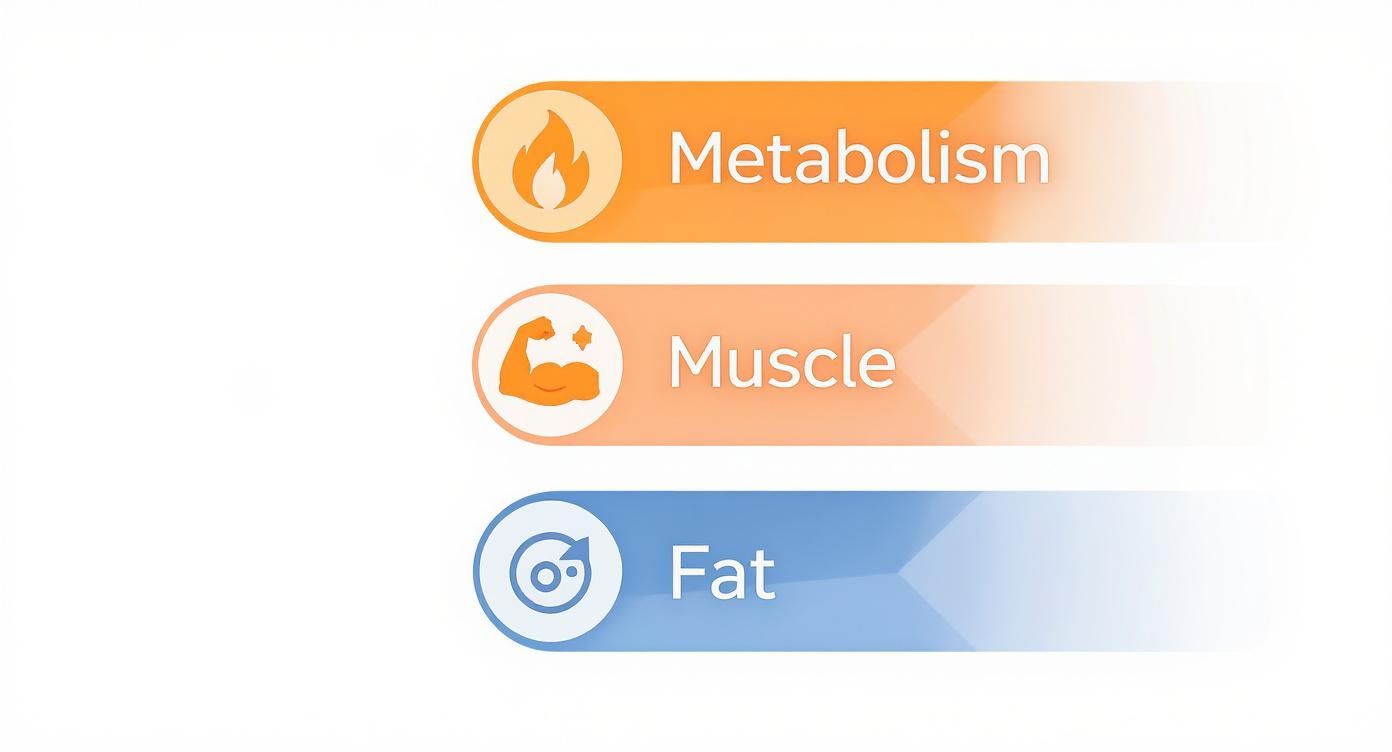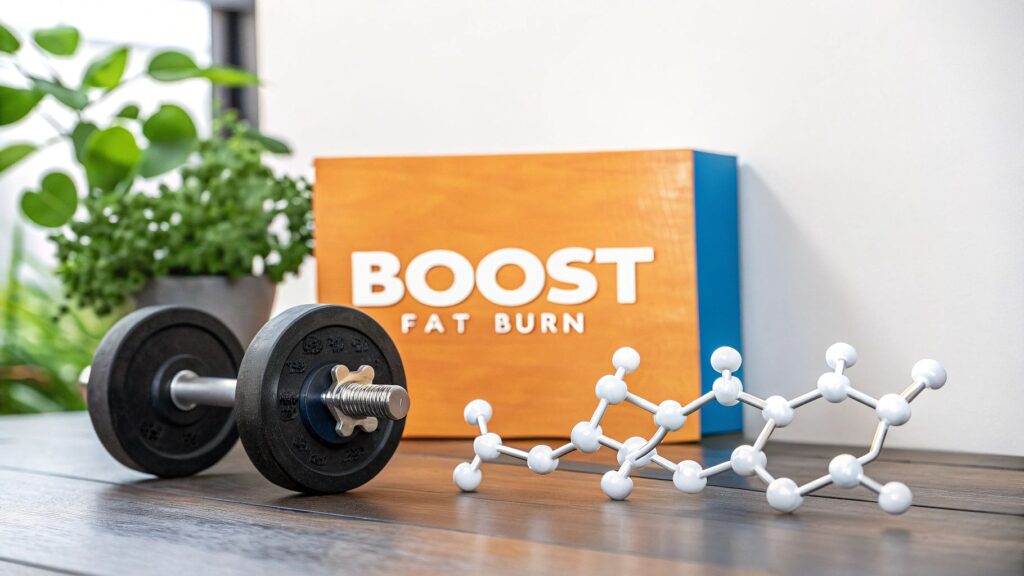If you're putting in the work at the gym and in the kitchen but the scale just won’t budge—especially when it comes to stubborn belly fat—the problem might be deeper than just calories in, calories out. Low testosterone can throw a wrench in your body's metabolic machinery, making weight loss feel like an impossible uphill climb.
TRT for weight loss isn't a quick fix or a miracle drug. It’s a targeted medical therapy designed to correct a real hormonal imbalance, giving your body back its natural ability to burn fat and build lean muscle.
The Link Between Testosterone and Stubborn Weight Gain

Think of testosterone as the general manager of your body composition. It gives clear, direct orders to build muscle and use stored fat for energy. But when your T levels drop, that communication system breaks down. Your body’s metabolic engine sputters, leading to fatigue, muscle loss, and a frustrating tendency to store more fat.
This puts you in a tough spot where your body is biologically programmed to gain weight, not lose it. Even with a perfect diet and a consistent workout plan, low testosterone can leave you feeling like you’re just spinning your wheels. The energy for those high-intensity workouts vanishes, and recovery feels painfully slow.
The Downward Spiral of Hormones and Weight
Low testosterone and weight gain feed into each other, creating a vicious cycle that’s incredibly hard to escape. First, lower testosterone levels cause you to lose muscle mass, which immediately slows down your metabolism. A sluggish metabolism makes it far easier to gain fat, especially visceral fat that collects around your vital organs.
But this new fat tissue isn't just sitting there. It actively works against you by producing an enzyme called aromatase. This enzyme’s job is to convert what little testosterone you have left into estrogen, which drives your T levels even lower and kicks the whole cycle into overdrive.
This hormonal feedback loop can feel like a physiological trap, making it nearly impossible to break free without addressing the root cause: the testosterone deficiency itself. It’s a frustrating scenario where gaining weight actively suppresses the very hormone you need to fight it. To get out of this cycle, you first have to understand where your levels should be. Reviewing a detailed guide to testosterone levels by age is a great first step.
The table below breaks down exactly how this hormonal imbalance makes managing your weight so difficult.
How Low Testosterone Impacts Your Body's Weight Regulation
| Physiological Factor | Impact of Low Testosterone | Resulting Challenge |
|---|---|---|
| Muscle Mass | Decreases lean muscle tissue (sarcopenia). | A slower resting metabolism, meaning you burn fewer calories. |
| Fat Storage | Promotes the accumulation of visceral (belly) fat. | Increased risk of metabolic syndrome and insulin resistance. |
| Aromatase Activity | Increased fat tissue leads to higher aromatase production. | More testosterone is converted to estrogen, worsening the hormonal imbalance. |
| Energy & Motivation | Causes persistent fatigue and low motivation. | Difficulty maintaining a consistent and intense exercise routine. |
| Insulin Sensitivity | Reduces the body's ability to process blood sugar effectively. | Promotes fat storage and makes it harder to lose weight. |
As you can see, low testosterone creates a cascade of metabolic problems that stack the deck against you, making every aspect of weight management harder.
Restoring Balance for Effective Fat Loss
The goal of TRT is to restore your testosterone to an optimal, healthy range—effectively hitting the reset button on your metabolism. It’s not about artificially forcing weight loss. Instead, it’s about creating the right hormonal environment where your diet and exercise efforts can finally start paying off.
Long-term studies really drive this point home. A comprehensive analysis tracking men with obesity and low testosterone for over 11 years found that sustained TRT led to an average body weight loss of around 20%. This wasn't just from cutting calories; it was a result of improved body composition, better energy metabolism, and the renewed motivation to stick with healthier habits.
By correcting the core hormonal imbalance, TRT helps your body function the way it’s supposed to. It turns the tide back in your favor, making sustainable weight loss a realistic and achievable goal.
How TRT Helps Your Body Burn Fat and Build Muscle
When you restore your testosterone levels, it’s like a skilled factory manager finally returning to the job. Suddenly, the whole metabolic operation starts running smoothly again. The real benefit of using TRT for weight loss isn't some kind of magic trick; it’s about fixing a core hormonal imbalance and letting your body work the way it was meant to.
Getting your testosterone back into its optimal range kicks off a series of positive changes that completely shift how you store fat and build muscle. It essentially rewires your body’s default setting from "store fat" to "burn fuel," creating the perfect internal environment for you to see real, lasting progress.
Turning Up Your Metabolic Furnace
One of the first things healthy testosterone levels do is crank up your basal metabolic rate (BMR). Think of your BMR as the energy your body burns just to keep the lights on—breathing, circulating blood, and keeping you warm. When testosterone is low, that metabolic furnace is stuck on a low, sluggish setting.
Restoring testosterone turns up the heat. A higher BMR means you’re burning more calories 24/7, even when you're just sitting at your desk or sleeping. This metabolic upgrade is a game-changer because it makes creating a calorie deficit so much easier, turning the frustrating goal of fat loss into something genuinely achievable.
This boost is largely driven by testosterone’s powerful anabolic effects—its natural ability to build tissue. It fires up protein synthesis, the process your body uses to repair and grow lean muscle fibers after you work out.
Key Insight: More muscle is metabolically expensive. Every pound of muscle you carry burns more calories at rest than a pound of fat. A more muscular body is a more efficient, calorie-burning machine by default.
Shifting from Fat Storage to Fat Burning
Testosterone doesn't just help you burn more calories; it changes the way your body deals with fat cells. With low T, your body is programmed to store energy as fat—especially the dangerous visceral fat that wraps around your organs and fuels metabolic diseases.
TRT helps flip this switch in two critical ways:
- It Blocks Fat Storage: Healthy testosterone levels send signals that slow down the creation of new fat cells (a process called adipogenesis). It’s like telling your body, "We're not prioritizing fat storage anymore."
- It Promotes Fat Release: It also encourages existing fat cells to release stored fatty acids, making them available for your body to use as fuel. This turns your fat reserves into an accessible energy source.
This one-two punch is what makes TRT for weight loss so effective. It’s not just about a faster metabolism; it’s about fundamentally changing your body’s relationship with fat, turning it from a storage-hoarding machine into a lean, fat-burning engine.
The Crucial Psychological Boost
The physical changes are only half the battle. The psychological shift that comes with balanced hormones is just as critical for long-term success. Low testosterone often drags down your energy, kills your motivation, and leaves you in a perpetually downbeat mood.
When your energy comes roaring back, that trip to the gym no longer feels like climbing a mountain. You have the drive to stick with your workouts and the mental clarity to make better choices in the kitchen. This renewed vitality is the spark that makes sustainable lifestyle changes feel possible, not punishing.
- Improved Energy: You’ll have more in the tank for workouts and everything else life throws at you.
- Enhanced Mood: A more positive outlook makes it easier to stay on track and committed to your goals.
- Increased Motivation: That desire to be active and take control of your health finally returns.
Ultimately, TRT gives you both the physical ability and the mental willpower to succeed. It clears away the hormonal roadblocks that were holding you back, empowering you to finally get the results your hard work has always deserved.
What Clinical Studies Reveal About TRT and Weight Loss
While the biological theory makes perfect sense, the real proof that TRT for weight loss works is found in solid clinical research. We're moving past the "how" and looking at hard data from long-term studies that show just how effective this therapy can be for men diagnosed with hypogonadism. This is where the rubber meets the road, giving us a clear picture of the measurable, lasting impact of restoring healthy testosterone levels.
For years, researchers have been tracking TRT's effects on the body composition of men with low T, and the results have been consistently positive. We're not talking about a quick, temporary drop on the scale. The data points to significant, long-term improvements in body weight, waist circumference, and overall metabolic health—the kind of evidence that gives medical professionals real confidence in using TRT as a foundational treatment.
Evidence from Long-Term Observational Studies
Some of the most compelling proof comes from studies that follow men over many years. These long-term observations show that the benefits of TRT aren't just a short-lived boost; they represent a progressive and lasting change. The results consistently point toward a fundamental shift in the body's metabolic baseline.
One landmark 5-year study in Germany followed 255 hypogonadal men and delivered some truly remarkable findings. Men receiving long-acting testosterone injections lost an average of 36 pounds, and here's the kicker: they weren't put on a mandatory diet or exercise program. Researchers noted that the weight loss was continuous, starting with a 4% reduction after one year and growing to over 13% by the fifth year. This strongly suggests TRT was the primary driver of their sustained weight reduction, a conclusion you can explore in a detailed report on the study's metabolic outcomes.
The infographic below breaks down how TRT creates these powerful changes on a biological level.

As you can see, it's a three-pronged attack: TRT revs up your metabolism, helps build lean muscle, and signals your body to stop storing so much fat. These pillars work together to drive real, sustainable weight loss.
Measurable Improvements in Body Composition
The data goes well beyond just the number on the scale. Clinical trials consistently show significant changes in body composition, which is arguably a much better yardstick for your health. Participants across various studies have seen notable drops in their waist circumference—a key indicator of dangerous visceral fat—and a decrease in their overall Body Mass Index (BMI).
These aren't just cosmetic changes; they represent a profound improvement in metabolic health from the inside out.
Key Takeaway: Clinical evidence shows that TRT helps the body preferentially burn fat while holding onto, or even building, lean muscle mass. This is the gold standard for sustainable weight loss and better physical function.
This shift is so important because it gets to the heart of the problem with low testosterone: a body that's hormonally programmed to store fat and shed muscle. By flipping that switch, TRT helps create a more metabolically active and resilient physique. It's a gradual process, and understanding the TRT results timeline can help you set realistic expectations for your own journey.
TRT as a Catalyst for Healthier Habits
While many studies show that TRT works even without a strict lifestyle overhaul, it’s best to think of the therapy as a powerful catalyst. The increased energy, better mood, and renewed drive that men on TRT report aren't just nice side effects—they are critical ingredients for long-term success.
This renewed vitality empowers you to actually stick with a diet and exercise plan, magnifying the therapy's effects. The research paints a clear picture: TRT for weight loss is most effective when it serves as the foundation upon which you build a healthier lifestyle. It removes the hormonal roadblocks, allowing diet and exercise to finally give you the results you've been working for.
Are You a Candidate For Testosterone Replacement Therapy?

Let's get one crucial point straight right from the start: Testosterone Replacement Therapy is a medical treatment, not a cosmetic shortcut. While the TRT for weight loss benefits are a welcome side effect for the right person, the therapy itself is prescribed to correct a diagnosed medical condition—hypogonadism, or clinically low testosterone.
This distinction is the single most important factor in figuring out if you're a candidate. The journey to TRT doesn't begin with a desire to drop a few pounds; it starts by identifying a legitimate health problem that needs medical intervention. The goal is to restore your body’s natural hormonal balance, which then allows it to function properly and makes weight management possible again.
Recognizing The Symptoms of Low Testosterone
The first step is often just realizing that something feels off. Many guys chalk up the signs of low testosterone to "just getting older," but persistent symptoms that chip away at your quality of life deserve a much closer look. Unexplained weight gain is a big red flag, but it almost never shows up alone.
Common symptoms that often point to a hormonal imbalance include:
- Persistent Fatigue: A bone-deep exhaustion that sleep just doesn't seem to fix.
- Decreased Libido: A noticeable and frustrating drop in your sex drive.
- Loss of Muscle Mass: Feeling weaker or seeing less definition, even if you’re still hitting the gym.
- Mood Changes: Finding yourself more irritable, down, or just lacking motivation.
- Brain Fog: Struggling to concentrate or feeling like your mind is stuck in mud.
If this cluster of symptoms hits a little too close to home, it might be time to move from self-assessment to a professional diagnosis. These are your body's signals that an underlying issue, like low testosterone, could be the real culprit.
The Necessity of Comprehensive Blood Testing
Symptoms point you in the right direction, but they aren't enough for a diagnosis. The only way to know for sure if you have low testosterone is through comprehensive blood work. A simple blood test is the bedrock of a proper diagnosis, giving you the objective, hard data needed to confirm hypogonadism.
And it’s not just about one number. A proper hormone panel measures several key markers to paint a complete picture of what’s going on inside your body.
Crucial Diagnostic Markers: A proper evaluation will measure both your total testosterone (the overall amount in your blood) and your free testosterone (the active, usable hormone). Without both, the diagnosis is incomplete.
This detailed analysis helps a doctor understand not just if your levels are low, but potentially why. It ensures TRT is the right tool for the job. For anyone looking to get a clear starting point, it's now easier than ever to learn more about the convenience of an at-home testosterone test to get an initial baseline.
Before we move on, it's vital to understand the difference between feeling like something is wrong and having the medical data to prove it. This table breaks down common symptoms versus the required diagnostic actions.
Common Symptoms vs. Diagnostic Steps for Low Testosterone
| Common Symptom/Feeling | Required Medical Diagnostic Action | What This Determines |
|---|---|---|
| Feeling constantly tired and unmotivated. | Comprehensive Blood Panel | Measures Total and Free Testosterone, Estradiol, SHBG, and other key hormones to confirm a clinical deficiency. |
| Gaining weight, especially around the middle. | Physical Examination & Health History | Rules out other potential causes of weight gain and assesses overall health profile. |
| Losing muscle and strength. | Lab Work Analysis & Symptom Correlation | Connects the physical symptoms directly to the objective data from blood tests to form a diagnosis. |
| Experiencing low libido or mood swings. | Screening for Contraindications | Checks for conditions like prostate issues or sleep apnea that would make TRT unsafe. |
As you can see, turning a vague feeling into a treatable condition requires a methodical, evidence-based approach.
The Role of a Qualified Healthcare Provider
Interpreting lab results and designing a safe, effective treatment plan is a job for a qualified medical professional. A doctor will take your blood work and look at it in the context of your symptoms, age, and overall health to make an informed diagnosis.
This consultation is also critical for screening for any contraindications—pre-existing conditions that would make TRT unsafe. This could include a history of prostate cancer, certain heart conditions, or untreated sleep apnea. A thorough medical evaluation ensures that the benefits of therapy will far outweigh any potential risks.
Deciding to start TRT should always be a collaborative process between you and your provider, built on a foundation of clear diagnostic evidence. That partnership is the key to reaching your health goals safely and effectively.
Getting Started: What Your TRT Journey for Weight Management Really Looks Like
Taking the first step to correct low testosterone can feel like a major decision, but knowing what’s ahead makes the process much less intimidating. Using TRT for weight loss isn't about a magic pill; it’s a medically guided process to restore your body’s natural hormonal engine. With the right guidance and a clear roadmap, it can be an empowering and straightforward path.
Your first real decision, made with your doctor, is how you'll administer the testosterone. There’s no single "best" method for everyone. The right choice for you will come down to your lifestyle, personal preference, and how your body responds. Each option has its own set of pros and cons, making it a personal call.
Choosing Your Treatment Method
Once you have a confirmed diagnosis of hypogonadism, you and your doctor will pick a delivery method. The goal is always the same: to keep your testosterone levels stable and in an optimal range. How you get there can vary.
Here’s a breakdown of the most common options on the table:
- Testosterone Injections: Often seen as the gold standard for a reason—they're effective and generally the most affordable. You can get them from a clinician or do them yourself at home, usually once or twice a week. They deliver a predictable, potent dose but obviously require being comfortable with needles.
- Topical Gels: A very popular non-invasive choice you apply to your skin daily. Gels provide a steady absorption of hormones, which does a good job of mimicking your body’s natural rhythm. The biggest downside? You have to be careful not to transfer it to a partner or family member through skin contact.
- Transdermal Patches: These are another daily option. You stick a patch on your skin, and it slowly releases testosterone over a 24-hour period. They’re convenient, but some guys find they cause skin irritation where the patch is applied.
- Subdermal Pellets: If you're looking for a low-maintenance, "set it and forget it" solution, this is it. A doctor surgically implants tiny pellets under your skin, and they release a steady dose of testosterone for three to six months. No daily gels or weekly shots needed.
Talking through the realities of each option with your provider is a must. Your daily routine, budget, and comfort level will all steer you toward the method that fits your life perfectly.
Setting a Realistic Results Timeline
This is critical: TRT starts working on a hormonal level almost immediately, but the physical changes you can see and feel are a marathon, not a sprint. Managing your expectations from day one is the key to staying motivated as your body adjusts.
Many men report a noticeable lift in their energy, mood, and mental focus within the first few weeks. That initial psychological boost is often the very first sign that the therapy is hitting the mark. But the deeper changes to your body composition—the heart of using TRT for weight loss—take a bit more time to show up.
Realistic Expectations: While you might feel better pretty quickly, significant fat loss and new muscle gain typically become noticeable after about 3 to 6 months of consistent treatment. These improvements often continue to build for years as your metabolism fires up and you accumulate more lean mass.
Think of it like getting a factory back online after a shutdown. The first changes are all internal—the power comes on, and the machinery starts humming. The visible results, like finished products rolling off the line, only come later once that foundation is solid.
The Critical Role of Medical Supervision
Your TRT journey isn't something you can just "set and forget." It is an active medical treatment that absolutely requires ongoing monitoring to keep it safe and effective for the long haul. Regular follow-ups with your doctor are a non-negotiable part of any successful TRT plan.
This supervision mostly revolves around periodic blood work. These tests are essential for a few very important reasons:
- Hormone Level Monitoring: To make sure your testosterone levels are dialed into the optimal therapeutic range—not too high, and not too low.
- Managing Estrogen: To keep an eye on your estradiol levels, since some testosterone naturally converts to estrogen. Your doctor may need to make adjustments to keep this conversion in check.
- Checking Red Blood Cells: To monitor your hematocrit. TRT can sometimes ramp up red blood cell production, and this needs to be managed to avoid potential issues.
This constant oversight allows your provider to make precise tweaks to your dose or even your delivery method over time. It’s how you get all the benefits of the therapy while keeping any potential risks to a minimum, making sure your path to better health is both safe and sustainable.
Maximizing Your Results and Ensuring Safety on TRT

Starting Testosterone Replacement Therapy can feel like you’ve finally unlocked your body’s true potential. But it's crucial to see it as a powerful partner, not a magic pill. The best TRT for weight loss results happen when the therapy works in sync with a solid nutrition plan and a consistent workout routine.
Think of TRT as the key that starts your metabolic engine; you still need to provide the high-quality fuel and actually drive the car.
Restoring your hormone levels creates the ideal internal environment for building muscle and burning fat. But your lifestyle choices are what will ultimately amplify those effects. You now have the energy and metabolic support to make every bit of effort count like never before. This is your chance to build a healthier, stronger body on a solid hormonal foundation.
Synergizing TRT with Smart Lifestyle Choices
To really get the most out of your treatment, you need to dial in two key areas: nutrition and exercise. Your body is now primed for muscle growth, so a diet rich in lean protein is absolutely essential. You've got to supply your body with the building blocks it needs to repair and grow stronger after each workout.
Strength training is your new best friend. Because testosterone directly promotes protein synthesis, lifting weights will yield far better results than before. This creates a fantastic positive feedback loop:
- TRT enhances muscle growth from your workouts.
- More muscle mass boosts your resting metabolism.
- A higher metabolism helps you burn more fat, even when you're resting.
This powerful combination is what drives significant, sustainable changes in your body composition over time, transforming you into a far more efficient, fat-burning machine.
Prioritizing Safety Through Medical Oversight
While the benefits are substantial, TRT is a medical treatment that demands respect and careful management. Being an active, informed participant in your own health journey is non-negotiable for ensuring both safety and success. Ongoing collaboration with your healthcare provider is the absolute cornerstone of a responsible TRT protocol.
Regular blood work isn't optional; it’s essential for monitoring key health markers and making sure your body is responding correctly. Your doctor will track several important metrics to keep your treatment dialed in perfectly.
Critical Safety Monitoring: A responsible TRT plan involves regular checks on your hematocrit (red blood cell concentration), PSA (prostate-specific antigen), and estradiol (estrogen) levels. This prevents potential complications and ensures your hormones remain in a healthy, balanced range.
This diligent oversight allows your doctor to make precise adjustments to your dosage, making sure you get all the benefits of optimized testosterone without taking on unnecessary risks. Staying proactive and communicative with your provider is the best way to safeguard your long-term health.
The impact of this medically supervised approach is profound. One landmark decade-long study on men with low testosterone and obesity found that TRT led to an average weight loss of 22.9 kg (about a 20.3% decrease in body weight) compared to an untreated group. The TRT group also saw their waistlines shrink by an average of 12.5 cm, showcasing a dramatic reduction in dangerous belly fat. Read more about these powerful research findings on TRT and obesity to understand the long-term benefits.
Your Top Questions About TRT for Weight Loss, Answered
When you’re exploring hormone therapy, it’s natural to have a lot of questions. Let’s cut through the noise and get straight to the answers for the most common things men ask about using TRT for weight loss.
How Quickly Will I Actually Lose Weight on TRT?
Think of TRT as a long-term investment, not a quick fix. While many men feel a surge in energy within just a few weeks, the real changes to your body composition—the kind you can see and feel—typically start showing up after about 3-6 months.
This isn't an overnight transformation. The process is gradual and sustainable. Studies show that as your body builds more lean muscle and sheds stubborn fat, these improvements keep building, often year after year.
Is TRT a Safe Option for Any Guy Trying to Lose Weight?
No, and this is a critical point. TRT is a specific medical treatment designed for men who have clinically diagnosed low testosterone (hypogonadism), which must be confirmed with blood tests.
It is absolutely not a weight loss drug for the general public. It's also not safe for men with certain health issues, like prostate cancer or severe heart conditions. A full medical evaluation by a qualified doctor is the only way to know if you're a safe and appropriate candidate.
Important Clarification: TRT is not an elective cosmetic treatment. Its primary purpose is to correct a documented hormonal deficiency. For the right men, significant improvements in weight management are a powerful and positive secondary benefit.
Will I Still Need to Diet and Exercise on TRT?
Absolutely. The best way to think of TRT is as the tool that finally makes all your hard work count. It creates the ideal hormonal environment for your body to burn fat and build muscle, but it doesn’t replace the need for a healthy lifestyle.
The real magic happens when you combine TRT with a solid nutrition plan and consistent exercise, especially strength training. This therapy empowers your body to respond properly to your efforts, turning what was once a frustrating, uphill battle into a journey where your actions finally deliver the progress you deserve.
Ready to take the next step in your health journey? At Elite Bioscience, we provide medically guided therapies to help you restore balance and achieve your wellness goals.
Discover how our TRT programs can support your health by visiting us at https://elitebioscience.co







